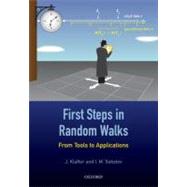
Note: Supplemental materials are not guaranteed with Rental or Used book purchases.
Purchase Benefits
Looking to rent a book? Rent First Steps in Random Walks From Tools to Applications [ISBN: 9780199234868] for the semester, quarter, and short term or search our site for other textbooks by Klafter, J.; Sokolov, I. M.. Renting a textbook can save you up to 90% from the cost of buying.
| Abbreviations | p. vii |
| Characteristic functions | p. 1 |
| First example: A random walk on a one-dimensional lattice | p. 2 |
| More general considerations | p. 4 |
| The moments | p. 6 |
| Random walk as a process with independent increments | p. 6 |
| A pedestrian approach to the Central Limit Theorem | p. 7 |
| When the Central Limit Theorem breaks down | p. 10 |
| Random walks in higher dimensions | p. 13 |
| Generating functions and applications | p. 17 |
| Definitions and properties | p. 17 |
| Tauberian theorems | p. 19 |
| Application to random walks: The first-passage and return probabilities | p. 21 |
| Mean number of distinct visited sites | p. 27 |
| Sparre Andersen theorem | p. 29 |
| Continuous-time random walks | p. 36 |
| Waiting-time distributions | p. 36 |
| Transforming steps into time | p. 39 |
| Moments of displacement in CTRW | p. 42 |
| Power-law waiting-time distributions | p. 43 |
| Mean number of steps, MSD, and probability of being at the origin | p. 49 |
| Other characteristic properties of heavy-tailed CTRW | p. 51 |
| CTRW and aging phenomena | p. 54 |
| When the process ages | p. 54 |
| Forward waiting time | p. 55 |
| PDF of the walker's positions | p. 60 |
| Moving time averages | p. 62 |
| Response to the time-dependent field | p. 65 |
| Master equations | p. 68 |
| A heuristic derivation of the generalized master equation | p. 70 |
| A note on time-dependent transition probabilities | p. 74 |
| Relation between the solutions to the generalized and the customary master equations | p. 75 |
| Generalized Fokker-Planck and diffusion equations | p. 77 |
| Fractional diffusion and Fokker-Planck equations for subdiffusion | p. 80 |
| Riemann-Liouville and Weyl derivatives | p. 80 |
| Grunwald-Letnikov representation | p. 83 |
| Fractional diffusion equation | p. 84 |
| Eigenfunction expansion | p. 89 |
| Subordination and the forms of the PDFs | p. 92 |
| Lévy flights | p. 97 |
| General Lévy distributions | p. 98 |
| Space-fractional diffusion equation for Lévy nights | p. 102 |
| Leapover | p. 104 |
| Simulation of Lévy distributions | p. 106 |
| Coupled CTRW and Lévy walks | p. 110 |
| Space-time coupled CTRWs | p. 110 |
| Lévy walks | p. 114 |
| Lévy walk interrupted by rests | p. 119 |
| Simple reactions: A + B → B | p. 123 |
| Configurational averaging | p. 123 |
| A target problem | p. 125 |
| Trapping problem | p. 127 |
| Asymptotics of trapping kinetics in one dimension | p. 129 |
| Trapping in higher dimensions | p. 132 |
| Random walks on percolation structures | p. 135 |
| Some facts about percolation | p. 137 |
| Fractals | p. 139 |
| Random walks on fractals | p. 141 |
| Calculating the spectral dimension | p. 143 |
| Using the spectral dimension | p. 145 |
| The role of finite clusters | p. 147 |
| Index | p. 151 |
| Table of Contents provided by Ingram. All Rights Reserved. |
The New copy of this book will include any supplemental materials advertised. Please check the title of the book to determine if it should include any access cards, study guides, lab manuals, CDs, etc.
The Used, Rental and eBook copies of this book are not guaranteed to include any supplemental materials. Typically, only the book itself is included. This is true even if the title states it includes any access cards, study guides, lab manuals, CDs, etc.